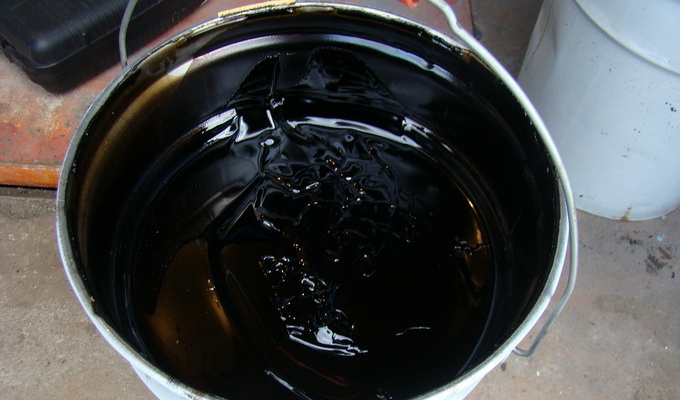
Oxidized Bitumen 90-10
Oxidized Bitumen 90-10 is made by ongoing or Staggered Blowing Process. Heated Penetration bitumen under controlled environment is blown with air which controls oil content in bitumen while it oxidized.
The different grades for suited applications produced are designated by two numbers to indicate the mid-points of their softening point and penetration ranges.
In addition vapour of oxidized bitumen or mist can cause headache, nausea, irritation of nose and lungs. Oxidized bitumen eye contact can cause slight irritation. Also its prolonged or continual skin contact can reasons slight skin irritation. In addition, oxidized bitumen can cause thermal burns which may finish in permanent skin injury. Furthermore hot product may cause severe eye burns and/or vision defect. oxidized bitumen is not classified as-dangerous for the atmosphere. Also as inflammable.
Contact of hot material with water will finish in vio-Lententide growth and splashing or boil-over may occur.
Application of Blown Bitumen 90/10:
Blown Bitumen 90/10 is produced by either Continuous or Staggered Blowing Process. Heated Penetration Grade Bitumen under controlled environment is blown with air which controls the Oil Content in the Bitumen while it oxidized. The different grades for suited applications produced are designated by two numbers to indicate the mid-points of their softening point and penetration ranges.
Chemical Mine World Oxidized Bitumen 90/10 is widely used as an anti-slip layer compound in the piling industry, for the manufacture of roofing felts, the roofing and waterproofing industries, for sound dampening felts and under carriage sealant in the automotive industry, electric cable joint protection, joint filling compound, carpet-backing, corrosion protection, acoustic panels, chemical, fuel, Manufacture of paints, sealant compound, and many others.
Also used in sealing saw cuts and joints where expected movements are minimum.
It is also used in the manufacturing of bituminous marine mastic for the oil & gas pipeline joints.
Further, Oxidized Bitumen is used in the manufacture of bituminous marine mastic, which is required for the oil and gas pipeline joints.
Also used in sealing saw cuts and joints where expected movements are minimum.
It is also used in the manufacturing of bituminous marine mastic for the oil & gas pipeline joints.
Further, Oxidized Bitumen is used in the manufacture of bituminous marine mastic, which is required for the oil and gas pipeline joints.
Oxidized bitumen is used as sealing of expansion joints.
Oxidized bitumen is used as repair of joints or cracks.
Oxidized bitumen is used as fixation of parquet floors.
Oxidized bitumen is used as adhesive to be used in thermal insulation.
Oxidized bitumen is used as repair of unexposed cracks.
Oxidized bitumen is used as bonding of wet briquettes
Oxidized bitumen is used in various industries like roofing, isolation, insulation flooring, mastics, pipe coatings, electrical applications.
Technical Advantages of Blown Bitumen 90/10:
- Durability
- Flexibility
- Water Resistant
- Chemical Stability
Compared to paving grade bitumen:
- Reduced temperature susceptibility
- Exhibits a more ‘solid’ nature at ambient temperatures
- High penetration index
Handling / Storage:
Heating of packaged bitumen is a critical phase in most of the final uses. Typically, the packaged material is heated and melted in boilers out on site.
However, control at the heating phase is very important in terms of health and safety as well as in maintaining the quality of the product.
Note must be taken of the maximum safe handling temperature of 230 C and this should not be abused. Bitumen is a poor conductor of heat, consequently, control of the heating phase is of paramount importance.
The Blown Bitumen material should be broken up prior to placement in the boiler. This exposes a larger surface area to the heat and encourages a more even heating regime. Without the larger exposed surface area, aggressive heating at the base and sides of the boiler may well result in localized overheating, altering the characteristics of the Chemical Mine World modified bitumen and potentially causing thermal cracking of the bitumen, creating the release of low lash vapors.
The flash point of the oxidized bitumen then becomes irrelevant; as these low flash vapors determine the fire risk.
Melted bitumen should not be left in the boiler and reheated from cold, as there is then a high potential for localized overheating around the heating area (lack of convection means poor heat transfer) and potential development of a pressurized pocket of low flash vapors.
Be aware of the placement of any temperature monitoring or control devices. As a result of the poor thermal conductivity of the bitumen, a thermometer in the bitumen some distance from the heat source could read significantly different (even hundreds of degrees) from the true temperature of the bitumen near the heat source.
For Health and Safety information, please make reference to the relevant MSDS.
Health & Safety:
Workers should wear protective masks, gloves, and goggles during application. The asphalt can be removed from equipment and tools with kerosene or gasoline. Care should be taken when heating Blown Bitumen 90/10 to avoid over heating.
Packing of blown asphalt 90/10:
The Chemical Mine World is manufacturer of blown asphalt 90/10 in various packing including kraft bag, meltable plastic bag, drum and bulk blown asphalt 90/10 from penetration grade bitumen, which is blown by hot air in a controlled process until the desired specification
is reached. The Chemical Mine World oxidised bitumen 90/10 can be supplied in any grade and are designated by two numbers to indicate the softening point and penetration ranges.
The oxidized asphalt grade 90/10 means softening point is 90°c and penetration is 10 desimillimiter is produced in compliance and conformity to ASTM standard and meets the following specification.
Data Sheet of Blown Bitumen 90/10:
| Bitumen 90/10 | Test method | Unit | Specification |
| Specific gravity @25/25 C | ASTM D70 | (Kg/m3) | 1.05 approx. |
| Penetration @ 25°c | ASTM D5 | mm/10 | 5-15 |
| Softening point °c | ASTM D36 | °C | 85/95 |
| Ductility @25 °c | ASTM D113 | Cm | 1.5min |
| Loss on heating(wt) % | ASTM D6 | Wt. % | 0.2 max |
| Flash point c | ASTM D92 | °C | 250 min |
| Solubility is CS2(wt) % | ASTM D4 | Wt. % | 99.5 max |
| Spot test | A.A.S.H.O.T102 | — | Negative |




